Autism and the DSM-5: What's the Big Deal?
The 'DSM' is the big rulebook for mental health diagnoses in the US. In 2013, its fifth edition (the DSM-5) completely changed how autism was defined, rolling several conditions into one big 'Autism Spectrum Disorder.' This guide breaks down what that book is, why they made the change, and what it all means in the real world.
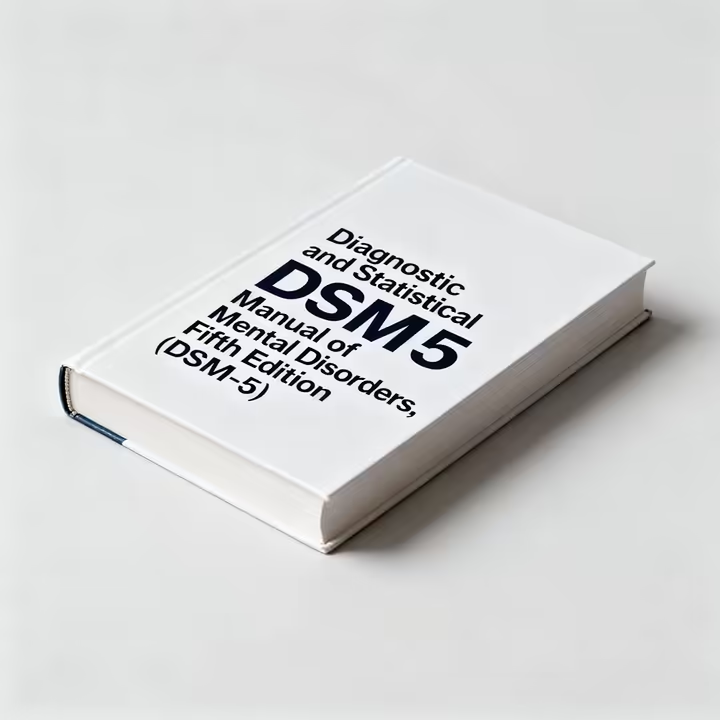
What Is This DSM Thing, Anyway?
The Diagnostic and Statistical Manual of Mental Disorders (DSM) is basically the official dictionary for mental health pros. Published by the American Psychiatric Association (APA), the DSM-5 gives everyone a common language for conditions. 1 This means a doctor in Texas and a therapist in Maine are talking about the same thing when they diagnose something. It keeps everyone on the same page for treatment and research. 3
But the DSM-5 is more than a clinical guide, it's a key to getting help. Insurance companies and government agencies often need a DSM diagnosis to pay for therapy or support services. 2 A diagnosis can unlock access to school accommodations and financial aid. 7 That's a lot of power for one book...
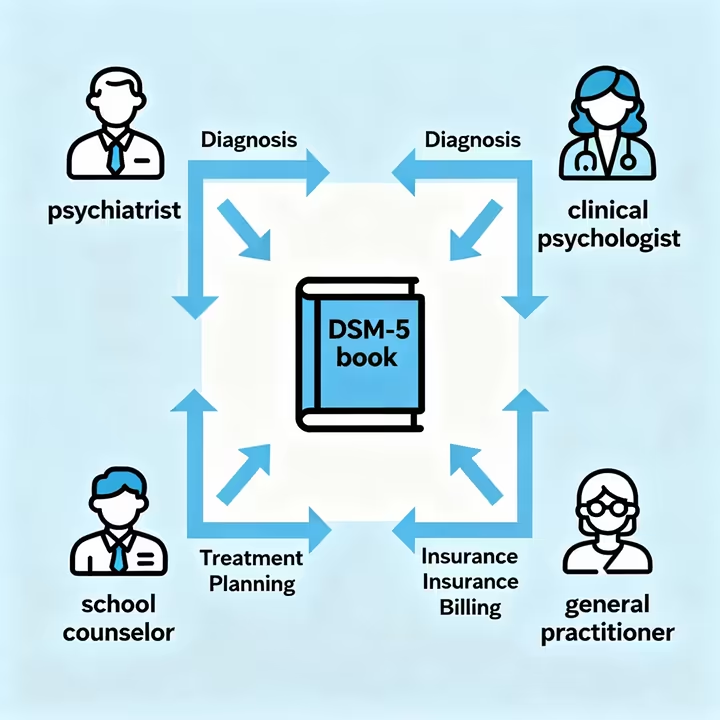
Who uses this thing? Pretty much everyone. Psychiatrists, psychologists, social workers, and counselors use it for diagnosis and treatment plans. 5 Even family doctors use it to spot issues and make referrals. 8
A DSM diagnosis describes a pattern of symptoms and behaviors that mess with someone's daily life (at school, work, or socially). 10 The book organizes disorders by what you can see, not by their deep-down causes. 12 It gives codes for billing, lists of criteria for diagnosis, and extra info on each condition, but it's a man-made guide, not perfect science... which is why the 2013 changes to the autism diagnosis were such a bombshell. 10
The Big Change: One Spectrum to Rule Them All
In 2013, the DSM-5 dropped a bomb on the autism world. It got rid of separate diagnoses like Autistic Disorder, Asperger's Disorder, and Pervasive Developmental Disorder-Not Otherwise Specified (PDD-NOS). 13 Instead, it created one big umbrella category: Autism Spectrum Disorder (ASD). The experts behind the change said the old labels were too inconsistent and scientifically unreliable. 15
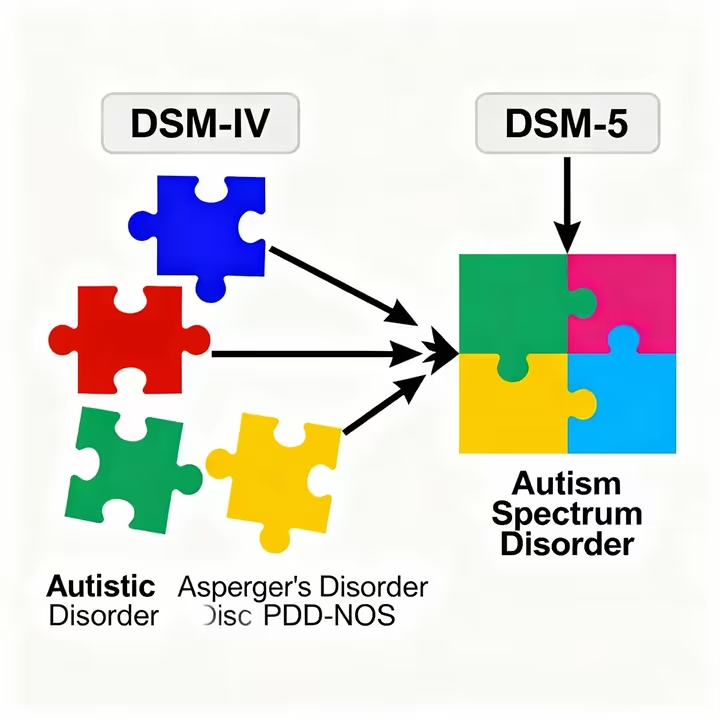
Why Mash Them Together?
The main reason for the change? Consistency... or the lack of it. Studies showed that getting a diagnosis of Asperger's vs. "high-functioning autism" often depended more on which clinic you went to than on your actual symptoms. 15 The lines were just too blurry. 15 The experts argued there wasn't strong scientific proof (from genetics or brain scans) that these were truly separate conditions, so they decided to tidy things up. 15
But What About My Identity?
For many people, "Asperger's" or "Aspie" was a core part of their identity, not just a clinical label. 18 It gave a name to feeling different and connected them to a community of people who got it. 19 The Asperger's label often felt less stigmatizing than "autism," sometimes being associated with intelligence. 17
Losing that label felt like a betrayal to many, like their identity was being erased. 18 People were angry and scared their unique traits would get lost in the new, broad "autism" category. 17, 21 It was a classic clash, the scientists wanted a neat, reliable system, but in doing so, they wiped out a social distinction that meant the world to a lot of people. 19
So... How Do You Tell People Apart Now?
To handle the variety within this new single spectrum, the DSM-5 added two tools: specifiers and a whole new diagnosis.
Clinicians can now add "specifiers" to a diagnosis to give more detail. They can note if ASD comes "with or without accompanying intellectual impairment" or "with or without accompanying language impairment". 24 This was meant to create a more personalized picture of a person's abilities and needs. 15
The APA also created a new diagnosis: Social (Pragmatic) Communication Disorder (SCD). 27 This was for people with social communication problems who do not have the restricted and repetitive behaviors needed for an ASD diagnosis. 28 It was a sort of safety net, giving a diagnostic home to people who might no longer qualify for ASD but still needed support. 29
The Nitty-Gritty: What Makes an ASD Diagnosis?
To get an ASD diagnosis in the DSM-5, a person has to show issues in two main areas: social communication and social interaction, and restricted, repetitive behaviors. You need both. Let's break down what that actually looks like.
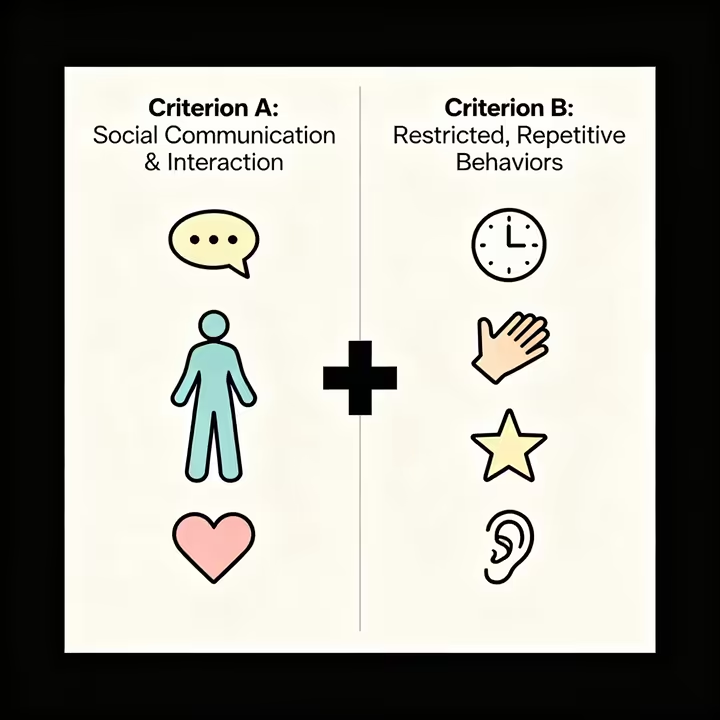
Part A: The Social Stuff
A person must show ongoing problems in all three of these social areas. It isn't about not wanting to connect; it's about the brain being wired differently for social stuff.
1. Social Back-and-Forth: This is the normal give-and-take of conversation. 31 It can look like walking up to someone and launching into a monologue, not taking turns in a chat, or not sharing excitement about something you see. 32
2. Nonverbal Communication: This is all about body language. 35 Think, poor eye contact, a flat facial expression even when saying something happy, or trouble understanding or using common gestures like waving or shrugging. 34, 36
3. Relationships: This covers the tricky business of making and keeping friends. 38 It could be trouble adjusting how you talk to different people (like a friend vs. a boss) or difficulty with imaginative play as a kid. 32, 34 It can look like a lack of interest in peers, but often it's a desire to connect without the built-in social manual. 33
Part B: The Repetitive Stuff
For this part, a person needs to show at least two of the following four behaviors. These actions are often a way to cope, bringing predictability to a world that can feel like sensory overload.
1. Repetitive Movements, Speech, or Use of Objects: This is the classic stuff. Think hand-flapping, body-rocking, lining up toys instead of playing with them, or repeating words and phrases (echolalia). 39, 32
2. Need for Sameness and Routine: A deep need for things to be predictable. 42 This means getting extremely distressed by small changes, like taking a new route to school. 31 It can also mean rigid thinking, eating the same food daily, or having trouble with transitions. 31
3. Intense, Focused Interests: Hobbies on steroids. 43 This is having an encyclopedic knowledge of a very specific topic, like train schedules or a single video game, that takes over everything else. 34 It can also mean a strong attachment to unusual objects. 38
4. Sensory Issues: A big new addition to the criteria. 44 This covers being over-sensitive (hyper-) or under-sensitive (hypo-) to sensory input. 44 Think, hating the feel of shirt tags, being bothered by normal sounds, or not noticing pain or cold. 45 It also includes sensory-seeking behaviors, like sniffing objects or being fascinated by spinning lights. 34
Levels of Support
Once the criteria are met, the clinician specifies a severity level based on how much support a person needs. There's Level 1 ("Requiring support"), Level 2 ("Requiring substantial support"), and Level 3 ("Requiring very substantial support"). 47 These levels aren't permanent and can change over time or in different situations. 14
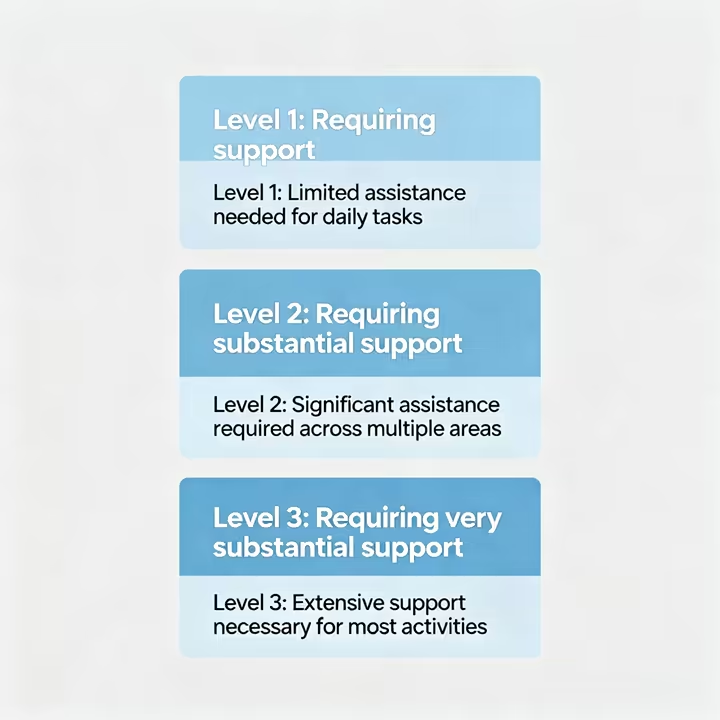
So what do the levels mean? Level 1 might involve someone who speaks in full sentences but struggles with social back-and-forth. Level 2 involves more obvious challenges in social communication, even with support. At Level 3, a person has severe social communication deficits and may have very few words, with repetitive behaviors that get in the way of everything. 47
The goal was to add detail, but many in the autism community worried these levels just created a new "high-functioning" vs. "low-functioning" divide. 48 'Level 1' could easily become a new stand-in for Asperger's. It shows how hard it is to use clinical labels without creating social ladders.
It Wasn't Just About Autism...
The fuss over the autism changes wasn't happening in a bubble. The whole DSM-5 revision was controversial. The autism community's complaints were part of a larger backlash... but with one very weird twist.
Too Many Diagnoses?
A big complaint was "diagnostic inflation." Critics, including the guy who led the last DSM, worried the new manual was making it too easy to diagnose people. 12 They argued it was pathologizing normal life, like labeling intense grief after a death as "major depression." 12 They feared it would create millions of new "patients" who didn't need to be. 52
Then there was the money. A huge percentage of the DSM-5 experts had financial ties to drug companies. 56, 57 Critics worried this could create a bias toward creating more diagnoses... which would mean selling more drugs. 53 This perception, real or not, made a lot of people distrust the whole process. 59
The Autism Paradox: Fear of Being Left Out
While everyone else was worried about over -diagnosis, the autism community had the opposite fear: under -diagnosis. The big concern was that the new, stricter autism criteria would kick people out who were previously diagnosed with Asperger's or PDD-NOS. 60 Studies suggested many could lose their diagnosis, and with it, access to school services, therapies, and support. 61, 16
So you had this weird situation. The DSM-5 was getting slammed for being too inclusive, but the autism community was slamming it for being too exclusive. It shows the changes weren't guided by one single idea; different expert groups made different calls. The autism community's story is a powerful counterpoint to the main narrative about the DSM-5.
Practical Stuff You Should Know
Okay, so let's get down to brass tacks. Here are answers to some common questions about the manual and getting a diagnosis.
How to Get Your Hands on the DSM
You can't legally get the DSM-5 for free online, those "free PDF" sites are usually sharing illegal copies. 63 The APA sells it as a book (hardcover, paperback, e-book). 63 You can also often access it through university or hospital library subscriptions, and some public libraries have copies. 5
What's This DSM-5-TR Thing?
In 2022, the APA released the DSM-5-TR. The "TR" stands for "Text Revision." It's an update, not a whole new version. 6 Most of the changes are just to the descriptive text to reflect new research. 51 A new diagnosis (Prolonged Grief Disorder) was added, but it wasn't a total overhaul. 6
Here's the key part for the autism community: the main diagnostic criteria for ASD did not change. 51 While the text was updated with clearer language, the core requirements are the same. 24 If you met the criteria for ASD in the DSM-5, you still meet them in the DSM-5-TR. Phew.
There's No "Autism Test"
You can't just take a "DSM-5 test" to get a diagnosis. That's not how it works. 70 A real ASD diagnosis comes from a big evaluation by a qualified pro, like a psychologist or developmental pediatrician. 68

What does that involve? Usually a detailed interview about your history, direct observation of your social skills (often using tools like the ADOS-2), and tests for things like IQ and language. 71, 70 They'll also talk to parents, teachers, or partners to get a full picture. 69 A diagnosis is a conclusion based on all this info, not a test score.
When's the DSM-6 Coming?
So, when is the DSM-6 coming out? Nobody knows. There's no official timeline for it. 72 Making a whole new edition is a massive job that takes over a decade, and the APA hasn't even started the process. 73
The APA might be moving away from giant, once-a-decade updates. Instead, we might see smaller, continuous updates, making the DSM a "living document." 73 This could mean faster fixes for problems in the criteria... or it could mean constant, confusing changes. The definition of autism is still an ongoing conversation between science, doctors, and autistic people themselves.
Works cited
- The DSM-5: Classification and criteria changes - PMC - PubMed Central, https://pmc.ncbi.nlm.nih.gov/articles/PMC3683251/
- DSM-5 - Wikipedia, https://en.wikipedia.org/wiki/DSM-5
- Psychiatry.org - Frequently Asked Questions - American Psychiatric Association, https://www.psychiatry.org/psychiatrists/practice/dsm/frequently-asked-questions
- my.clevelandclinic.org, https://my.clevelandclinic.org/health/articles/24291-diagnostic-and-statistical-manual-dsm-5#:~:text=It%20provides%20clear%2C%20highly%20detailed,organizes%20those%20conditions%20into%20groups.
- Diagnostic and Statistical Manual of Mental Disorders, Fifth Edition - Psychiatry Online, https://psychiatryonline.org/doi/book/10.1176/appi.books.9780890425596
- Diagnostic and Statistical Manual of Mental Disorders (DSM-5) Overview - Verywell Mind, https://www.verywellmind.com/the-diagnostic-and-statistical-manual-dsm-2795758
- Introduction - DSM-5 Changes - NCBI Bookshelf, https://www.ncbi.nlm.nih.gov/books/NBK519710/
- Five Professions that Use the DSM-5 - Online-Psychology-Degrees.org, https://www.online-psychology-degrees.org/list-articles/five-professions-that-use-the-dsm-5/
- The People Behind DSM-5 - American Psychiatric Association, https://www.psychiatry.org/File%20Library/Psychiatrists/Practice/DSM/APA_DSM_People-Behind-DSM-5.pdf
- About DSM-5-TR - American Psychiatric Association, https://www.psychiatry.org/psychiatrists/practice/dsm/about-dsm
- Patient-Centered Revisions to the DSM-5 | Journal of Ethics | American Medical Association, https://journalofethics.ama-assn.org/article/patient-centered-revisions-dsm-5/2011-12
- The perils of diagnostic inflation - PMC, https://pmc.ncbi.nlm.nih.gov/articles/PMC3537802/
- Highlights of Changes from DSM-IV-TR to DSM-5 - American Psychiatric Association, https://www.psychiatry.org/File%20Library/Psychiatrists/Practice/DSM/APA_DSM_Changes_from_DSM-IV-TR_-to_DSM-5.pdf
- Expert Q&A: DSM-5 and ASD | Autism Speaks, https://www.autismspeaks.org/science-blog/expert-qa-dsm-5-and-asd
- Why fold Asperger syndrome into autism spectrum disorder in the DSM-5? | The Transmitter, https://www.thetransmitter.org/spectrum/why-fold-asperger-syndrome-into-autism-spectrum-disorder-in-the-dsm-5/
- Debate remains over changes in DSM-5 a decade on | The Transmitter, https://www.thetransmitter.org/spectrum/debate-remains-over-changes-in-dsm-5-a-decade-on/
- DSM-5: What Happened to Asperger's? - Clay Center for Young Healthy Minds, https://www.mghclaycenter.org/parenting-concerns/families/dsm-5-what-happened-to-aspergers/
- When Asperger's Disorder Came Out - PubMed, https://pubmed.ncbi.nlm.nih.gov/28953765/
- The Change in Classification of Asperger Syndrome: An Exploration of its Effects on Self-Identity - NSUWorks, https://nsuworks.nova.edu/cgi/viewcontent.cgi?article=4122&context=tqr
- How the loss of Asperger syndrome has lasting repercussions | The Transmitter, https://www.thetransmitter.org/spectrum/how-the-loss-of-asperger-syndrome-has-lasting-repercussions/
- 'DSM-V is taking away our identity': the reaction of the online community to the proposed changes in the diagnosis of Asperger's disorder - PubMed, https://pubmed.ncbi.nlm.nih.gov/23739773/
- The DSM-5 proposed changes, and what it means to lives affected by autism / Asperger's Syndrome., https://livingautism.com/dsm-5-proposed-changes-means-lives-affected-autism-aspergers-syndrome/
- The Vanishing Diagnosis of Asperger's Disorder - Ivan Allen College of Liberal Arts, https://iac.gatech.edu/publications/pub/147
- Autism diagnostic criteria: DSM-5, https://www.autismspeaks.org/autism-diagnostic-criteria-dsm-5
- DSM-5-TR and autism diagnosis | Raising Children Network, https://raisingchildren.net.au/autism/learning-about-autism/assessment-diagnosis/dsm-5-autism-diagnosis
- Autism Spectrum Disorder Versus Autism Spectrum Disorders: Terminology, Concepts, and Clinical Practice - PMC, https://pmc.ncbi.nlm.nih.gov/articles/PMC7317665/
- DSM-V and How it Affects the Diagnosis of Asperger's Disorder, https://www.optimumperformanceinstitute.com/autism-treatment/dsm-v-and-how-it-affects-the-diagnosis-of-aspergers-disorder/
- Social (pragmatic) communication disorder - Wikipedia, https://en.wikipedia.org/wiki/Social_(pragmatic)_communication_disorder
- Social (Pragmatic) Communication Disorder - American Psychiatric Association, https://www.psychiatry.org/File%20Library/Psychiatrists/Practice/DSM/APA_DSM-5-Social-Communication-Disorder.pdf
- Social (Pragmatic) Communication Disorder DSM-5 315.39 (F80.89) - Therapedia, https://www.theravive.com/therapedia/social-(pragmatic)-communication-disorder-dsm--5-315.39-(f80.89)
- IACC Subcommittee Diagnostic Criteria - DSM-5 Planning Group, https://iacc.hhs.gov/about-iacc/subcommittees/resources/dsm5-diagnostic-criteria.shtml
- Diagnostic Criteria for Autism Spectrum Disorder in the DSM-5 | CHOP Research Institute, https://www.research.chop.edu/car-autism-roadmap/diagnostic-criteria-for-autism-spectrum-disorder-in-the-dsm-5
- DSM-5 AUTISM SPECTRUM DISORDER, https://depts.washington.edu/dbpeds/Screening%20Tools/DSM-5%28ASD.Guidelines%29Feb2013.pdf
- The Formal Diagnostic Criteria for Autism - Adult Autism Health Resources, https://www.adult-autism.health.harvard.edu/resources/the-formal-diagnostic-criteria-for-autism/
- DSM-5 criteria for autism spectrum disorder maximizes diagnostic sensitivity and specificity in preschool children - PMC, https://pmc.ncbi.nlm.nih.gov/articles/PMC6713264/
- A - PERSISTENT DEFICITS IN SOCIAL COMMUNICATION AND SOCIAL INTERACTION - CDC Stacks, https://stacks.cdc.gov/view/cdc/118834/cdc_118834_DS6.pdf
- Comparison of the Diagnostic Criteria for Autism Spectrum Disorder Across DSM-5,1 DSM-IV-TR,2 and, http://iris.peabody.vanderbilt.edu/wp-content/uploads/pdf_info_briefs/ASD_Comparison_information_brief.pdf
- Decoding autism in the DSM-5, https://embrace-autism.com/decoding-autism-in-the-dsm-5/
- Part B of the diagnostic criteria cause Part A - Aspiedent, https://aspiedent.com/blog/part-b-cause-part-a-autism-diagnostic-criteria/
- Stereotypic Movement Disorder: Symptoms & Treatment - Cleveland Clinic, https://my.clevelandclinic.org/health/diseases/stereotypic-movement-disorder
- Stereotypy in Autism: The Importance of Function - PMC, https://pmc.ncbi.nlm.nih.gov/articles/PMC2598746/
- Autism Spectrum Disorders: Diagnosis and Treatment - NCBI, https://www.ncbi.nlm.nih.gov/books/NBK573609/
- Autism spectrum disorder: definition, epidemiology, causes, and clinical evaluation - PMC, https://pmc.ncbi.nlm.nih.gov/articles/PMC7082249/
- Sensory Abnormalities in Autism Spectrum Disorders: A Focus on the Tactile Domain, From Genetic Mouse Models to the Clinic - PubMed Central, https://pmc.ncbi.nlm.nih.gov/articles/PMC6997554/
- Brief Report: DSM-5 Sensory Behaviours in Children With and Without an Autism Spectrum Disorder - King's College London Research Portal, https://kclpure.kcl.ac.uk/portal/files/55703196/Sensory_Behaviour_in_ASD_post_referreed_proof.pdf
- Sensory Features as Diagnostic Criteria for Autism, https://pmc.ncbi.nlm.nih.gov/articles/PMC4345540/
- ASD levels of severity - Autism Speaks, https://www.autismspeaks.org/levels-of-autism
- Understanding Types and Levels of Autism: A Full Guide, https://riseupforautism.com/blog/autism-levels-and-types
- Autism Spectrum / Understanding ASD Severity Levels - Columbia Regional Inclusive Services, https://www.crisoregon.org/Page/368
- Brief Report: DSM-5 “Levels of Support:” A Comment on Discrepant Conceptualizations of Severity in ASD - PubMed Central, https://pmc.ncbi.nlm.nih.gov/articles/PMC3989992/
- How the Diagnosis of Autism Has Changed Since the DSM-5 and DSM-5-TR, https://huntingtonpsych.com/blog/how-the-diagnosis-of-autism-has-changed-since-the-dsm-5-and-dsm-5-tr
- DSM 5 and Diagnostic Inflation - Psychology Today, https://www.psychologytoday.com/us/blog/dsm5-in-distress/201201/dsm-5-and-diagnostic-inflation
- The Debate Over DSM-5: A Step Backward - Psychotherapy Networker, https://www.psychotherapynetworker.org/article/debate-over-dsm-5-step-backward/
- DSM-5 two years later: facts, myths and some key open issues - PMC, https://pmc.ncbi.nlm.nih.gov/articles/PMC6998622/
- “Clinical judgment” and the DSM-5 diagnosis of major depression - PMC, https://pmc.ncbi.nlm.nih.gov/articles/PMC3683250/
- Confronting the Pharmaceutical Shadow in Psychiatry: Ethical Imperatives and the Integrity of Mental Health Practice | The BMJ, https://www.bmj.com/content/384/bmj-2023-076902/rr-4
- Diagnosing Conflict-of-Interest Disorder - AAUP, https://www.aaup.org/academe/issues/2010-issues-4/diagnosing-conflict-interest-disorder
- Undisclosed financial conflicts of interest in DSM-5-TR: cross sectional analysis - PMC, https://pmc.ncbi.nlm.nih.gov/articles/PMC10777894/
- Physicians who oversaw diagnostic manual's revision had pharma funding | The Transmitter, https://www.thetransmitter.org/science-and-society/physicians-who-oversaw-diagnostic-manuals-revision-had-pharma-funding/
- DSM-5 Diagnostic Criteria for Autism May Lower Diagnosis Rates, https://www.nursing.columbia.edu/news/dsm-5-diagnostic-criteria-autism-may-lower-diagnosis-rates
- ASCP Corner: Changes in the Diagnostic Criteria for Autism in DSM-5: Controversies and Concerns - Psychiatrist.com, https://www.psychiatrist.com/jcp/ascp-corner-changes-diagnostic-criteria-autism-ltemgtdsm/
- Despite fears, DSM-5 is a step forward | The Transmitter, https://www.thetransmitter.org/spectrum/despite-fears-dsm-5-is-a-step-forward/
- Diagnostic and Statistical Manual of Mental Disorders, Fifth Edition, Text Revision (DSM-5-TR - American Psychiatric Association Publishing, https://www.appi.org/Products/dsm
- askusatthelibrary.liberty.edu, https://askusatthelibrary.liberty.edu/faq/169997#:~:text=On%20the%20A%2DZ%20Databases%20page,available%20here%20in%20its%20entirety.
- Q. Can I access the DSM-5 online? - Search Frequently Asked Questions, https://askusatthelibrary.liberty.edu/faq/169997
- DSM-5-TR: Rationale, Process, and Overview of Changes | Psychiatric Services, https://psychiatryonline.org/doi/full/10.1176/appi.ps.20220334
- Autism in DSM-5-TR, what has changed? | Research, Society and Development, https://rsdjournal.org/rsd/article/view/46866
- jflowershealth.com, https://jflowershealth.com/comprehensive-diagnostic-evaluation-for-autism/#:~:text=It%20considers%20both%20the%20core,in%20selecting%20evidence%2Dbased%20interventions.
- Q. COMPREHENSIVE DIAGNOSTIC EVALUATION – AUTISM SPECTRUM DISORDER (ASD), https://www.cga.ct.gov/ph/bhpoc/op/related/20180101_2018/20180105/ASD%20Comprehensive%20Diagnostic%20Evaluation%20LOC%20Guideline.pdf
- Comprehensive Diagnostic Evaluation For Autism, https://jflowershealth.com/comprehensive-diagnostic-evaluation-for-autism/
- Comprehensive Autism Evaluations | University at Albany, https://www.albany.edu/autism/comprehensive-autism-evaluations
- DSM 6 Release Date Insights: What's Next for Autism? - Total Care ABA, https://www.totalcareaba.com/autism/dsm-six-release-date
- Dsm 6 Release Date - Milestone Achievements ABA, https://www.milestoneachievements.com/post/dsm-6-release-date
- Dsm 6 Release Date | Advanced Therapy Clinic, https://www.advancedtherapyclinic.com/blog/dsm-6-release-date
- When Will the DSM-6 Be Released? - Goldstar Rehabilitation, https://www.goldstarrehab.com/parent-resources/when-is-the-dsm-6-likely-to-be-released